Moderate overlap front: original test
Rating applies to 2003-08 models built after December 2002
Tested vehicle: 2003 Toyota Corolla LE 4-door
The Toyota Corolla was redesigned for the 2003 model year.
The Insurance Institute for Highway Safety has evaluated the crashworthiness of the Corolla in two 40 mph frontal offset crash tests into deformable barriers. In the first test, forces on the right tibia were high enough to indicate the possibility of lower leg injury. This led Toyota to modify a portion of the padding underneath the carpeting on models produced after December, 2002. (Note: information about when a specific vehicle was manufactured is on the certification label typically affixed to the car on or near the driver door.) The Institute tested a second Corolla that had been retrofitted with the improved padding, and forces on the lower right leg were reduced so that significant injury was unlikely.
| Evaluation criteria | Rating |
|---|---|
| Overall evaluation | |
| Structure and safety cage | |
| Driver injury measures | |
| Head/neck | |
| Chest | |
| Leg/foot, left | |
| Leg/foot, right | |
| Driver restraints and dummy kinematics | |
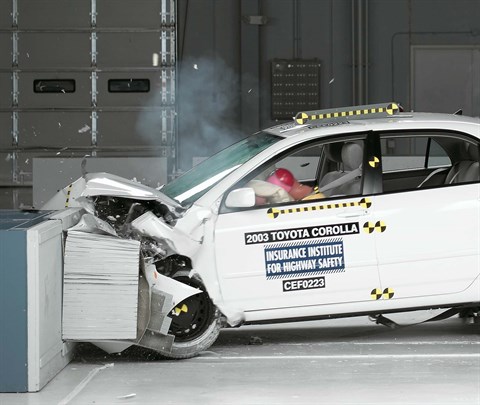
Action shot taken during the second of two frontal offset crash tests.

The dummy's position in relation to the steering wheel and instrument panel after the second crash test indicates that the driver's survival space was maintained well.
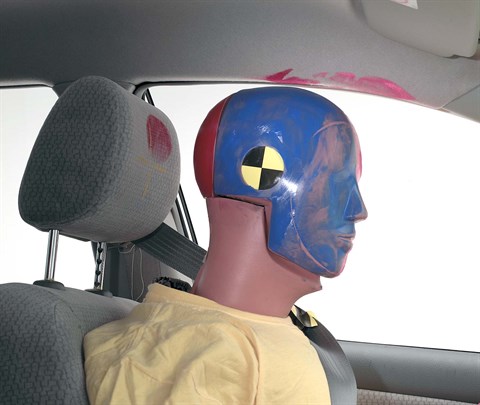
Smeared greasepaint indicates where the dummy's head hit the roof rail during rebound in the second test. Head acceleration from this hit was low.
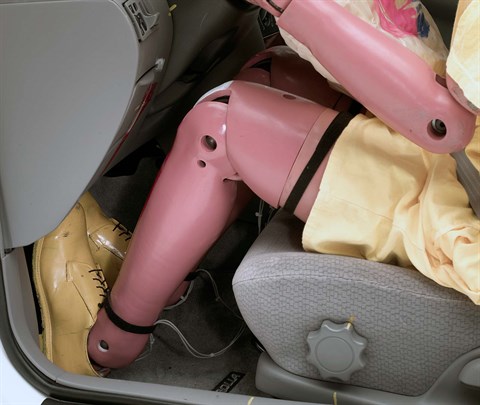
Intrusion into the driver's space was minimal, and all leg and foot injury measures were low in the second test.
Rating applies to 2003 models built before January 2003
Tested vehicle: 2003 Toyota Corolla LE 4-door
The Toyota Corolla was redesigned for the 2003 model year.
The Insurance Institute for Highway Safety has evaluated the crashworthiness of the Corolla in two 40 mph frontal offset crash tests into deformable barriers. In the first test, forces on the right tibia were high enough to indicate the possibility of lower leg injury. This led Toyota to modify a portion of the padding underneath the carpeting on models produced after December, 2002. (Note: information about when a specific vehicle was manufactured is on the certification label typically affixed to the car on or near the driver door.) The Institute tested a second Corolla that had been retrofitted with the improved padding, and forces on the lower right leg were reduced so that significant injury was unlikely.
| Evaluation criteria | Rating |
|---|---|
| Overall evaluation | |
| Structure and safety cage | |
| Driver injury measures | |
| Head/neck | |
| Chest | |
| Leg/foot, left | |
| Leg/foot, right | |
| Driver restraints and dummy kinematics | |
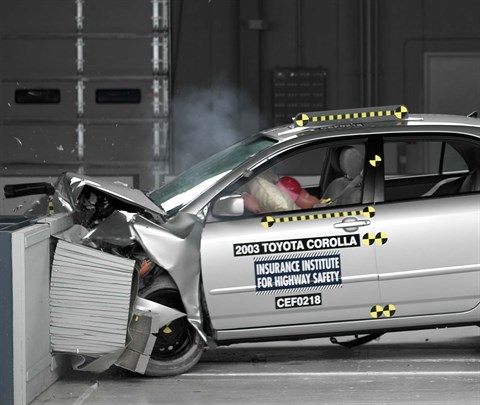
Action shot taken during the first of two frontal offset crash tests.

The dummy's position in relation to the steering wheel and instrument panel after the first crash test indicates that the driver's survival space was maintained well.
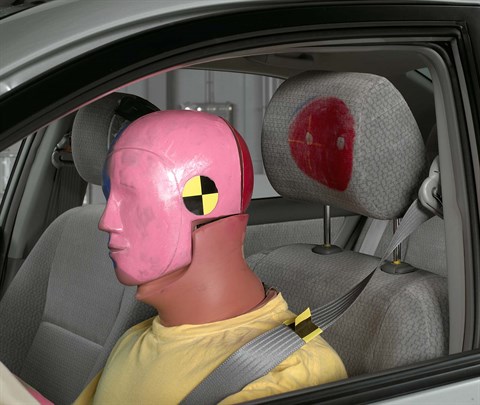
Dummy movement was well controlled in the first test. During rebound, the dummy's head hit only the head restraint.
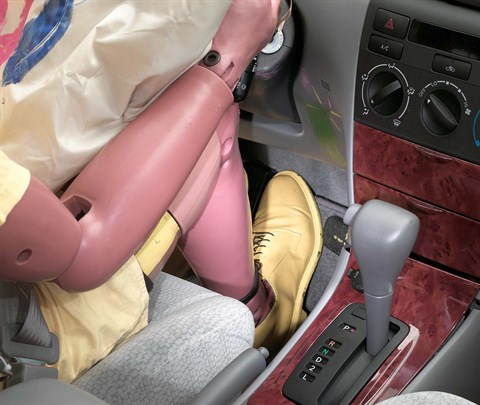
Forces on the lower right leg were high enough to indicate the possibility of injury in the first test.
Side: original test
Rating applies to 2003-08 models
Tested vehicle: 2005 Toyota Corolla LE 4-door without optional side airbags
The Toyota Corolla was redesigned for the 2003 model year. Side curtain airbags designed to protect front and rear occupants’ heads became optional beginning with 2005 models, in addition to the optional side airbags designed to protect drivers’ and front passengers’ torsos available since 2003.
Two tests of a Corolla were conducted, one with optional side airbags for the driver and rear passenger, and one without. These vehicles are rated separately, except that the structural ratings for both vehicles are based on both tests.
| Evaluation criteria | Rating |
|---|---|
| Overall evaluation | |
| Structure and safety cage | |
| Driver injury measures | |
| Head/neck | |
| Torso | |
| Pelvis/leg | |
| Driver head protection The dummy's head was hit by the intruding barrier, producing high head injury measures. | |
| Rear passenger injury measures | |
| Head/neck | |
| Torso | |
| Pelvis/leg | |
| Rear passenger head protection The dummy's head was hit by the pillar behind the rear passenger door. This pillar is required by federal standard to provide some protection for occupants' heads. | |
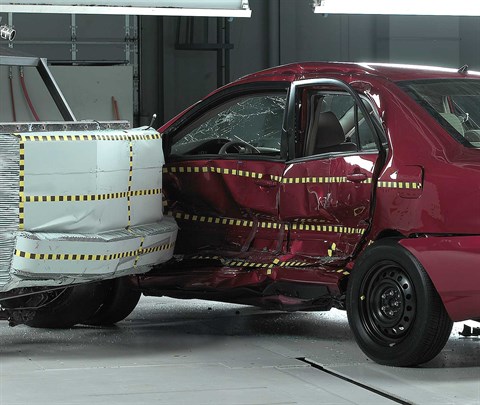
View of the vehicle and barrier just after the crash test.

View of the vehicle after the crash with doors removed, showing damage to the occupant compartment.
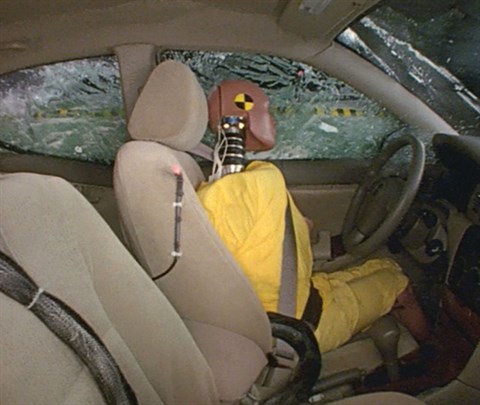
Action shot taken during the side impact crash test showing the driver dummy's head being hit by the intruding barrier.
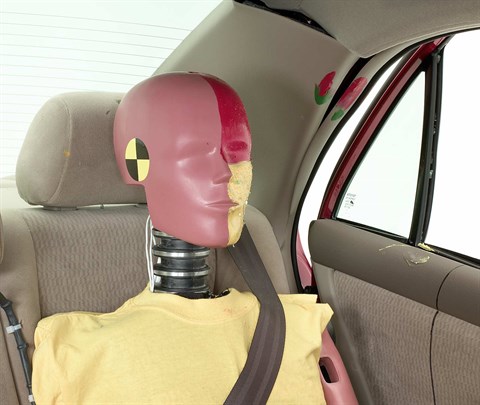
Smeared greasepaint shows where the rear passenger dummy's head was hit by the pillar behind the rear passenger door.
Head restraints & seats
Seat type: Seats with adjustable height
| Overall evaluation | |
|---|---|
| Dynamic rating | |
| Seat/head restraint geometry |
About the head restraint & seat test
Currently, IIHS tests apply only to front seats.
